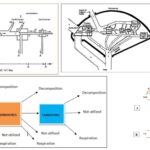Differentiate between: (a) Racemose and cymose inflorescence (b) Apocarpous and syncarpous ovary
(a) In racemose inflorescence, the main axis continues to grow and the flowers are borne laterally in an acropetal succession, e.g., mustard. In cymose inflorescence, the main axis terminates in a flower and the subsequent growth is by lateral branches, which also end in flowers, showing basipetal succession, e.g., jasmine. (b) An apocarpous ovary has multiple free carpels, e.g., lotus. A syncarpous ovary has multiple carpels that are fused together, e.g., mustard.
Please login to submit an answer.
(a) In racemose inflorescence, the main axis continues to grow and the flowers are borne laterally in an acropetal succession, e.g., mustard. In cymose inflorescence, the main axis terminates in a flower and the subsequent growth is by lateral branches, which also end in flowers, showing basipetal succession, e.g., jasmine. (b) An apocarpous ovary has multiple free carpels, e.g., lotus. A syncarpous ovary has multiple carpels that are fused together, e.g., mustard.
- Share on Facebook
- Share on Twitter
- Share on LinkedIn
Helpful: 0%




